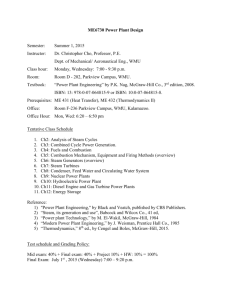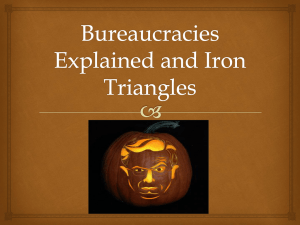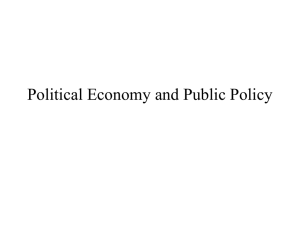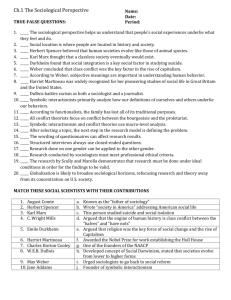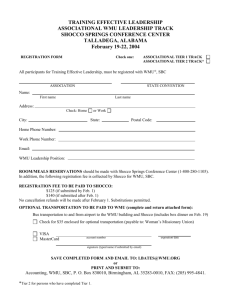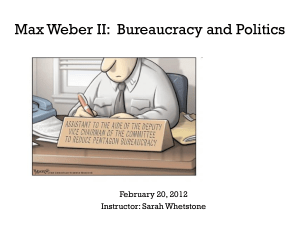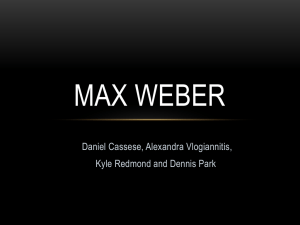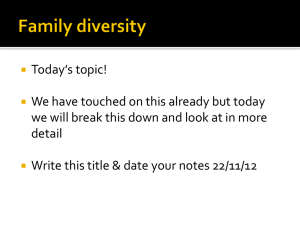SOC 2000 Fall 2014 EXAM #2 Sample Questions Prof. Ciccantell 1
advertisement
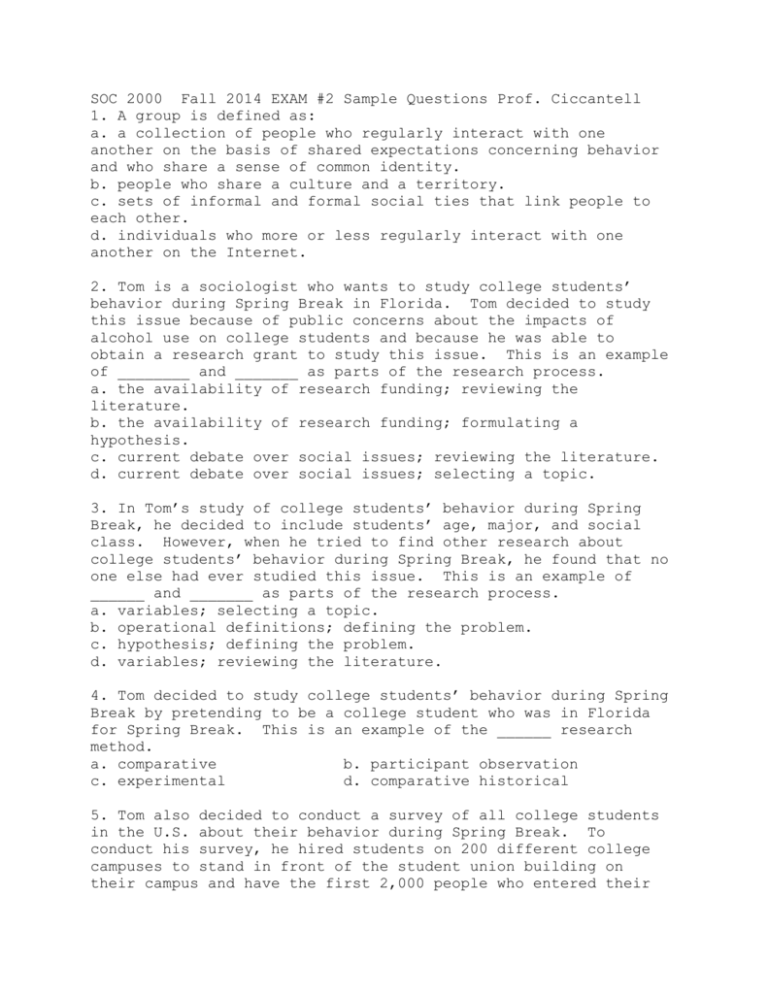
SOC 2000 Fall 2014 EXAM #2 Sample Questions Prof. Ciccantell 1. A group is defined as: a. a collection of people who regularly interact with one another on the basis of shared expectations concerning behavior and who share a sense of common identity. b. people who share a culture and a territory. c. sets of informal and formal social ties that link people to each other. d. individuals who more or less regularly interact with one another on the Internet. 2. Tom is a sociologist who wants to study college students’ behavior during Spring Break in Florida. Tom decided to study this issue because of public concerns about the impacts of alcohol use on college students and because he was able to obtain a research grant to study this issue. This is an example of ________ and _______ as parts of the research process. a. the availability of research funding; reviewing the literature. b. the availability of research funding; formulating a hypothesis. c. current debate over social issues; reviewing the literature. d. current debate over social issues; selecting a topic. 3. In Tom’s study of college students’ behavior during Spring Break, he decided to include students’ age, major, and social class. However, when he tried to find other research about college students’ behavior during Spring Break, he found that no one else had ever studied this issue. This is an example of ______ and _______ as parts of the research process. a. variables; selecting a topic. b. operational definitions; defining the problem. c. hypothesis; defining the problem. d. variables; reviewing the literature. 4. Tom decided to study college students’ behavior during Spring Break by pretending to be a college student who was in Florida for Spring Break. This is an example of the ______ research method. a. comparative b. participant observation c. experimental d. comparative historical 5. Tom also decided to conduct a survey of all college students in the U.S. about their behavior during Spring Break. To conduct his survey, he hired students on 200 different college campuses to stand in front of the student union building on their campus and have the first 2,000 people who entered their union building during the first week of April to fill out his survey, giving him 400,000 completed surveys, a huge number of responses. On his surveys, he asked students questions such as “How much did you drink during Spring Break?” and “Every year, dozens of college students die in drunk driving accidents, from alcohol poisoning, and from other alcohol-related causes; is drinking during Spring Break a good thing?” This is an example of all of the following challenges in doing sociological research using surveys EXCEPT: a. the accuracy and honesty of answers. b. the wording of questions. c. spurious correlation. d. how to achieve a random sample. 6. Edward owned a business that made horse-drawn wagons in the year 1800. Many of Edward’s competitors had built wagon factories that used steam engines and machines to build wagons and were producing many more wagons each year, hiring hundreds of new employees, and building dozens of new factories all across England. However, Edward’s company still made wagons by hand, just as Edward’s great-grandfather’s company had done eighty years earlier. Edward’s company went bankrupt in 1802. This is an example of all of the following EXCEPT: a. Marx’s explanation for the rationalization of society. b. tradition. c. the importance of rationalization in the transition from traditional to modern societies. d. Weber’s explanation for the rationalization of society. 7. Subjects who are called a(n) _______ a. experimental c. independent not exposed to the independent variable are group. b. control d. dependent 8. Characteristics such as gender and race and ethnicity of the researcher are important factors in the ________ research method. a. survey b. participant observation c. comparative d. experimental 9. The topics chosen in class for designing our own research project included all of the following EXCEPT: a. parking. b. underage drinking. c. the effects of jobs on GPAs. d. dormitory life. 10. During the exam today, two students try to cheat and are caught. One student, Aaron, explains his cheating by saying that “I had three tests today, and if my GPA falls below 3.5, I’ll lose my scholarship. I didn’t have time to study, so I cheated.” The other student, Jerry, explained his cheating by saying that “all of my friends cheat, so why shouldn’t I?” Aaron is an example of the ________ theory of deviance, and Jerry is an example of the ________ theory of deviance. a. differential association; structural strain b. labeling theory; structural strain c. lack of social control; differential association d. structural strain; differential association 11. A group that is rationally designed to achieve its objects, often by means of explicit rules, regulations and procedures is defined as a: a. formal organization. b. bureaucracy. c. hierarchy. d. capitalist organization. 12. To understand how people go about changing social structure and social institutions is one reason why: a. Zimbardo conducted the prison experiment. b. sociologists do sociological research. c. Charles Horton Cooley studied primary and secondary groups. d. Charles Horton Cooley studied in-groups and out-groups. 13. Fred and five of his friends were WMU students in the year 2010 who were really frustrated by the parking problem on campus. Fred and his friends formed an organization called “Fix Our Campus Problems.” Fred and his friends were able to sign up several hundred students as supporters of their organization and created an organization with a president, vice-president, secretary and a treasurer, a constitution, and a set of rules for members. The group was able to get several of the group’s members elected to the student government in 2011. The student government then tried to set up a free shuttle bus system to make getting to and from campus easier and cheaper for students, but the university administration refused to provide funding. The group kept trying for years to solve the parking problem, and eventually, in the year 2016, forced the administration to begin building several new parking garages on campus strictly for student use. However, the group that had been founded to solve the parking problem did not disappear; instead, they began to lobby to improve the quality of food in the dormitory cafeterias and the student union. This is an example of all of the following EXCEPT: a. goal displacement. b. a secondary group. c. a bureaucracy. d. the Peter Principle. 14. _________ correlation is defined as a situation in which two variables are correlated but not causally related, since both are caused by a third variable. a. Tertiary b. False c. Experimental d. Spurious 15. Sociological curiosity is an important part of the _______ stage of the research process. a. selecting a topic. b. defining the problem. c. reviewing the literature. d. analyzing the results. 16. The key office at my former institution was used in class as an example of: a. hierarchy of authority. b. ritualism. c. the Peter Principle. d. goal displacement. 17. A group of twelve people who met in this class have been having lunch together every Tuesday and Thursday after class all semester. Last Thursday at lunch, one member of the group, John, said “My car is at the repair shop; could someone drive me there after lunch to pick it up?” However, no one offered to drive John, hoping that someone else would volunteer so that they would not have to go out of their way. Finally, Eric, who lived on the same dorm floor as John and who had spent more time with him than anyone else in the group, said “I’ll take you to get your car.” This is an example of all of the following EXCEPT: a. diffusion of responsibility. b. group dynamics. c. an aggregate. d. a clique. 18. One example of bureaucratic alienation is: a. the song "Billy Austin." b. the song “Feel Like a Number.” c. the Asch Experiment. d. the Milgram Experiment. 19. Alan is one of six people scattered around the U.S. who belong to a Facebook group for fans of an obscure 1970s British band, Steve Harley and Cockney Rebel, who regularly discuss the band's music. Alan and Sarah, another regular participant in this Facebook group, began to spend an increasing amount of time messaging each other and eventually fell in love with each other and now plan to be married, even though they have never met face to face. This is an example of all of the following EXCEPT: a. an electronic community. b. a secondary group. c. an electronic primary group. d. a dyad. 20. This class is an example of all of the following EXCEPT: a. a secondary group. c. an in-group. b. a bureaucracy. d. a formal organization. 21. The research study that found that people were willing to obey authority and give what they thought were life-threatening shocks because someone in a position of authority ordered them to do so was the ________ Experiment. a. Asch b. Milgram c. Zimbardo d. Trump 22. In the survey research method, the target group to be studied is defined as the: a. sample. b. random sample. c. interview group. d. population. 23. The factor that causes a change in another variable is defined as the _________ variable. a. causal b. independent c. dependent d. experimental 24. Research on the death penalty has found that: a. sentencing and enforcement are often arbitrary. b. the death penalty is an effective deterrent to keep people from committing serious acts of deviance. c. the death penalty is the best means to solve the "broken windows" problem. d. the death penalty is an effective means of rehabilitation. 25. Elaine is the manager of a Burger King restaurant. Her job requires her to supervise the work of the assistant managers who supervise each shift, the cashiers who run the cash register and take food orders, and the cooks who prepare the food, and to fill out reports for her boss, the regional manager, about the operations of her restaurant. This is an example of all of the following characteristics of a bureaucracy EXCEPT: a. hierarchy of authority. b. division of labor. c. the Peter principle. d. written communications and records. 26. The key to the carrying out the research stage of the research process is: a. figuring out how the data fit together to form a pattern. b. following the rules of the research method chosen. c. developing operational definitions. d. deciding what variables to include. 27. The reason why the results of sociological research or any other type of scientific research can be trusted is because: a. experiments identify causal relationships by carefully controlling the situation. b. statistical analysis always provides accurate answers to scientific research questions. c. of replication. d. of correlation. 28. A social ______ is people who share a common characteristic but do not necessarily interact or identify with one another and a social ______ is a simple collection of people who happen to be together in a particular space but do not significantly interact or identify with one another. a. group; aggregate b. group; category c. aggregate; category d. category; aggregate 29. The acceptance of rules, efficiency, and practical results as the right way to approach human affairs is defined as: a. rationality. b. bureaucracy. c. formality. d. tradition. 30. Tom and Dan were best friends in high school and they both came to WMU together as freshmen and shared a dorm room. They met three other people who were majoring in the same subject and had similar tastes in music. The five of them spent all their free time together during their freshman year. Tom eventually decided to change majors and stopped hanging out with Dan and the other three, but Dan and the other three remained friends. This is an example of the group dynamic of: a. as a group grows larger, stability increases. b. leaders emerge in larger groups to allow the group to accomplish its goals. c. peer pressure causes people to conform to group pressure. d. in larger groups, people feel a diffusion of responsibility. 31. _______ argued that rationality resulted from economic and technological changes in society, but _______ argued that rationality resulted from Protestant religious beliefs. a. Weber; Durkheim b. Durkheim; Weber c. Marx; Weber d. Weber; Marx 32. Criminal activities by those in white-collar or professional jobs are called: a. youthful indiscretions. b. white collar crime. c. unlabeled deviance. d. street crime. 33. One group dynamic is that: a. as group size increases, intensity and intimacy increase and stability decreases. b. in large groups, people feel more responsible for other members and are more likely to help them. c. as group size increases, the degree of formality increases. d. in large groups, leadership is not necessary because discussion and debate can reach an agreement quickly. 34. Tim is a freshman at WMU enrolled in Sociology 2000. He has four tests and three papers due this week and he was called in to work for twenty hours over the weekend unexpectedly at his job off campus. In order to keep his scholarship, he has to maintain a 3.5 grade point average, so he has to do very well in all of his classes. Since he did not have any time available to study for this exam and knows that means he will flunk, he decides to cheat by copying the answers from one of his friends sitting near him. This is an example of the _______ theory of how people become deviants. a. differential association b. labeling c. structural strain d. inherited characteristics 35. Ralph is an eighteen year old freshman at WMU. All of his friends have fake I.D.’s and go to the bars every weekend to drink. Ralph has never drunk any alcohol, but his friends bought a fake I.D. for him and have been pressuring him to join them on the weekends. Ralph finally agrees to use the fake I.D. and go to the bars with them on Friday night. Ralph gets into a bar with the fake I.D., buys a beer, and is then arrested for being a minor in possession of alcohol and having a fake I.D. He goes to court and is sentenced to pay a fine and do 100 hours of community service. This is an example of all of the following EXCEPT: a. formal means of social control. b. informal means of social control. c. differential association. d. broken windows theory. 36. Deviance is all of the following EXCEPT: a. defined differently in different cultures. b. modes of action that do not conform to the norms or values held by most members of a group or society. c. the formal and informal means of enforcing norms in society. d. defined differently in different groups in the same society. 37. Alex is majoring in accounting. He has been talking to all of his parents’ friends who work for large companies in Chicago about whether their companies have any job openings for accountants. He has also contacted several WMU graduates who are now successful accountants to ask them for suggestions about what he should do to become successful like they are, and many of them have responded with advice and job leads because they want to help out a fellow WMU grad. This is an example of all of the following EXCEPT: a. a reference group. b. networking. c. an in-group. d. a clique. 38. Tom is a researcher who wants to study alcohol use among WMU students. He develops a survey that includes questions such as: “Have you ever been stupid enough to drink so much that you made yourself sick?” and “Have you ever been foolish enough to try to use a fake I.D. to get into a bar?” He has his survey printed in the Kalamazoo Gazette and asks WMU students who are interested and willing to tear out the survey, fill it out, and mail it to him. More than 1,000 WMU students fill out his questionnaire and mail it to him. When he analyzes his results, he finds that 90% of the people who answered his survey have never drunk so much to make themselves sick, 98% have never tried to use a fake I.D., and that only 20% of WMU students who answered his survey report that they ever drink any alcohol. This is an example of all of the following challenges in doing sociological research EXCEPT: a. the accuracy and honesty of answers to surveys. b. SLOP. c. the wording of survey questions. d. spurious correlation. 39. John is a researcher who is studying the impacts of divorce on children. He had always wondered how children reacted to their parents’ divorce, and after his own divorce, he wanted to understand what was happening to his own children. The frequent discussions of the impacts of the divorce rate on U.S. families by politicians and in the media reinforced his interest in studying this topic. This is an example of all of the following reasons to select a research topic EXCEPT: a. sociological curiosity. b. interest in a topic, often because of personal experiences or observations. c. the availability of research funding. d. current debate over social issues. 40. In John’s study of the impacts of divorce on children, he is examining how the age of children when their parents get divorced affects their performance in school. He measures the age of children as how many years old they were at the time of the divorce and he measures their school performance as their grade point average four years after their parents got divorced. He predicts that: the older children are when their parents divorce, the worse their performance in school will be. This is an example of all of the following aspects of the research process EXCEPT: a. a hypothesis. b. an operational definition. c. a variable. d. an experiment. 41. Validity is: a. the degree to which operational definitions produce consistent results. b. the degree to which an operational definition measures what it was intended to measure. c. whether the data fit together to form a pattern. d. how the results fit with existing research. 42. At WMU, students often take very large classes, have their exams graded by computers, and are asked for the I.D. numbers whenever they need help from the Registrar’s office, the Financial Aid office, or the dean of their college. This is an example of: a. impersonality. b. Parkinson’s Law. c. bureaucratic alienation. d. goal displacement. 43. Your family name, your status as a college student, and being a son or daughter are all examples of: a. networks. b. cliques. c. groups. d. reference groups. 44. The Literary Digest survey regarding the 1936 presidential election demonstrated the challenge in doing sociological research of: a. a larger sample size is not necessarily better. b. spurious correlation. c. the accuracy and honesty of answers to surveys d. SLOP. 45. The Milgram Experiment found that: a. prisoners in the experimental prison became withdrawn and sullen, while guards became abusive. b. the subjects were quite willing to give what they thought were life-threatening electric shocks because someone in authority ordered them to do so. c. people placed in an artificial laboratory setting do not act the way they would in the real world. d. people being studied in an experiment are not likely to give honest and accurate answers to questions. 46. The most important way to ensure the validity and reliability of a research study and the best reason to accept the findings of a research study is: a. correlation. b. replication. c. an experiment. d. whether it fits with your own personal experiences. 47. Jason murdered six people during a robbery at a convenience store. When he was asked why he killed these people, he answered “Because I thought it would be fun to watch them die.” After Jason was convicted of capital murder, the judge sentenced him to death, saying that “I want other criminals to see what happens to you and what will happen to them if they kill innocent people.” This is an example of: a. labeling theory. b. rehabilitation. c. deterrence. d. incapacitation. 48. The reason why we have so many bureaucracies is because: a. tradition dictates that all large groups of people must be organized into bureaucracies. b. government regulations require that all large groups of people must be organized into bureaucracies. c. having a hierarchy of authority in an organization such as a university allows professors to force students to suffer through exams like this one. d. bureaucracies make it possible to organize larger and larger groups of people. 49. A researcher who studied why people wait in line to order food at a fast food restaurant and why they don’t bargain over prices with the cashier is an example of which of the following reasons to do sociological research: a. to understand how people go about changing social structure and social institutions. b. to better understand how people live their everyday lives. c. to help large bureaucracies control what people do. d. to identify causal relationships by carefully controlling the situation. 50. Alan, Sam and Jack are all WMU students. They share an apartment, go out together on the weekends, and consider themselves to be best friends. This is an example of all of the following EXCEPT: a. a group. b. a category. c. a primary group. d. a reference group. 51. According to Max Weber, in traditional societies: a. spending money on yourself was sinful. b. capitalism was sinful. c. the past was believed to be the best guide for decisions that people had to make in the present. d. rationality stood in the way of industrialization because the rational thing to do in a traditional society was to do things the way they had always been done. 52. According to the structural strain theory of how people become deviants, giving up on the goals and means is called: a. innovation. b. ritualism. c. retreat. d. rebellion. 53. Sasha, a student in a sociology class, received his graded research paper. He was deducted points for not citing a famous study done five years ago that was nearly identical to the research he conducted. What step in the research process should he have done more carefully? a. define the research problem b. carry out the research c. interpret the results d. review the literature 54. For his research project in his sociology class, Jamal is studying eating disorders among college students. He is currently interviewing several subjects. What stage of the research process is he in now? a. define the research problem b. carry out the research c. interpret the results d. select an appropriate research design 55. Reilly, a sociology master’s student, wants to do research on the homeless in her city. She would like to provide a rich, detailed, inside view of being homeless. What research method should she choose? a. comparative research b. ethnography c. experiment d. historical analysis 56. Recently, social scientists using participant observation have written about how their race, class, gender, and sexual orientation: a. affected their research due to power differences b. allowed them to be completely objective about their work c. caused many researchers to go native d. did not affect the research process 57. Which research method would be best to use if you wanted a large, representative sample of people’s attitudes toward married women with children working outside the home? a. survey b. life history c. experiment d. ethnography 58. Kevin is interested in doing a study on student attitudes toward the general education requirements on his campus. He surveys 50 students. This small group of students he surveyed is known as the: a. population b. control group c. experimental group d. sample 59. A classic social science research study involved setting up a make-believe jail and randomly assigning male student volunteers to the roles of guards and prisoners. This research used what method? a. survey b. participant observation c. historical analysis d. experiment 60. In an experiment on the effects of caffeine on the alertness of college students, student volunteers are randomly assigned to two groups. One group is given caffeinated coffee while the other group is given decaffeinated coffee. All participants then play a video game to assess their mental acuity, measured as their final score on the video game. In this study, the group that is given caffeinated coffee is called the: a. control group b. experimental group c. focus group d. population 61. What calculation gives a researcher a good idea of how spread out a series of numbers is? a. mean b. median c. mode d. standard deviation 62. a. b. c. d. What is the most frequent figure in a series of numbers called? mean median mode standard deviation 63. Which of the following is a social aggregate? a. an unmarried couple who have been living together for less than one year b. middle-class Asian American women c. people waiting at Terminal C for Flight 181 d. your family 64. People milling around in crowds, waiting for a bus, or strolling on a beach make up a social: a. group b. triad c. aggregate d. category 65. People sharing a common characteristic, such as gender, occupation, or ethnicity, but not necessarily interacting with each other are called a social: a. triad b. group c. aggregate d. category 66. People who share common characteristics make up a: a. social network b. social group c. social category d. social aggregate 67. At Jamie’s high school, the “jocks” made fun of the drama club members. This increased the bonding and sense of loyalty among the jocks; therefore, we could consider the jocks: a. an out-group b. an in-group c. a network d. a social category 68. Reference groups provide us: a. the ability to be concerned with accomplishing a task b. the strict conformity to rigid organizational structures c. the impersonal anonymity of modern life d. a standard for judging one’s attitudes and behaviors 69. Dyads are fragile social groups because: a. if one person leaves, the group disappears b. one member can brainwash another c. they keep individuals from forming other relationships d. the relationships are too intense 70. What did we learn about students’ willingness to obey authority in the Stanley Milgram study? a. People will follow an authority figure’s orders regardless of the pain they might be inflicting on others. b. People will organize and establish their own rules, eliminating the expert. c. People will establish relationships among themselves, creating an in-group and an outgroup. d. No one will obey orders that have negative consequences for other people. 71. Soloman Asch’s experiment illustrated that: a. primary groups are the most influential groups in our lives b. people stammered and fidgeted before speaking out against group conformity c. many people are willing to discount their own perceptions rather than go against group consensus d. most people will express their own beliefs without considering the group opinion 72. Stanley Milgram’s experiment on obedience to authority occurred more than 40 years ago. Scientists do not replicate his experiment and update the findings because: a. more students are working away from campus and would not be available to participate b. universities are increasingly under pressure to reduce costs on lab and experiment work c. once the findings of a study are published, duplicating the research is a waste of time and money d. universities have installed increased research protocols to protect subjects 73. Stanley Milgram’s study on authority and obedience demonstrated that even in extraordinary situations, ordinary people will: a. conform to the expectations that they have for themselves b. resist authority c. obey those in positions of power d. exclude others 74. Max Weber believed that _______________ was the only way to cope with the administrative needs of large social systems. a. tradition b. bureaucracy c. surveillance d. emotion 75. Research by John Meyer and Brian Rowan found that the _______________ in a bureaucracy are often ceremonial or ritual, serving mainly to justify the way things are really done. a. formal procedures b. informal relations c. primary groups d. traditions 76. Michel Foucault showed that the physical architecture occupied by an organization reflects its: a. level of debt b. age c. system of authority d. gender distribution of its employees 77. Michel Foucault’s term for the supervision of activities in organizations is: a. power b. bureaucracy c. democracy d. surveillance 78. According to Michel Foucault, organizations “efficiently distribute bodies” and activities through the use of: a. democracy b. timetables c. the clan model d. the hierarchy of authority 79. According to Michel Foucault, timetables: a. efficiently distribute paychecks b. regulate activities across space and time c. allow workers to organize according to their managers d. allow managers to monitor the behavior of employees when they are not working 80.Oligarchy means: a. rule by the few b. corporate resistance c. specialization and expertise in bureaucracy d. anarchy 81. Robert Michels saw that in large-scale organizations and in societies dominated by such organizations, power is inevitably concentrated at the top. He called this the: a. clan model b. iron law of oligarchy c. panopticon d. surveillance society 82. The McDonaldization of society refers to the: a. obesity epidemic in American society b. taking over of key authority positions by baby boomers c. increased uniformity and rationality of society due to automation d. phenomenal success of McDonald’s restaurants as a model for other companies 83. Nonconformity to a set of norms accepted by a significant number of people in a community is called: a. sanction b. labeling c. devious d. deviance 84. Any reaction from others to the behavior of an individual meant to ensure that the individual complies with a given norm is called a: a. law b. punishment c. reward d. sanction 85. Sanctions applied by peer groups for actions such as making fun of someone’s clothes are: a. deviant b. formal c. informal d. internal 86. Émile Durkheim’s concept of _______________ describes a condition in which social norms lose their hold over individual behavior. a. anomie b. differential association c. labeling d. mechanical solidarity 87. According to Robert K. Merton’s structural strain theory, people who accept the cultural goals of success but use illegal means to achieve their goals, for example pimps, illustrate which mode of adaptation? a. conformity b. innovation c. rebellion d. retreatism 88. a. b. c. d. According to Edwin Sutherland, criminals adopt criminal behavior because they: are genetically predisposed to criminal activity enjoy being incarcerated in prisons learn criminal behavior from peers respond to rewards and punishments 89. Alice Goffman’s research on men wanted by the police found that issuing warrants on a large scale for low-level violations: a. benefits society by creating jobs in the criminal justice system b. is an effective strategy to deter crime in urban areas c. motivates poor black men to get jobs, pay child support, and see their children regularly d. transforms activities and social relations necessary to maintain a noncriminal identity into dangerous locations that could lead to arrest 90. Alice Goffman found that the men she studied who were wanted by the police for low-level violations reduced their likelihood of being arrested when they: a. were secretive and unpredictable about their whereabouts b. stayed at their mother’s house c. showed up to work regularly d. reported to court when required 91. In his study of a criminal gang in inner-city Chicago, Sudhir Venkatesh found that: a. even the lowest-level drug dealer made lots of money b. gang members had low aspirations c. gang members were unintelligent d. the gang ran its operations much like legitimate businesses 92. The process of bringing community and family members into court to publicly state their condemnation of a criminal’s behavior and to accept the responsibility for reintegrating the offender back into the community is called: a. community policing b. hazing c. labeling d. reintegrative shaming ANSWER KEY 1. A 2. D 3. D 4. B 5. C 6. D 7. B 8. B 9. D 10. D 11. A 12. B 13. D 14. D 15. A 16. B 17. C 18. B 19. B 20. C 21. B 22. D 23. B 24. A 25. C 26. B 27. C 28. D 29. A 30. A 31. C 32. B 33. C 34. C 35. D 36. C 37. D 38. D 39. C 40. D 41. B 42. C 43. C 44. A 45. B 46. B 47. C 48. D 49. B 50. D 51. C 52.. C 53. D 54. B 55. B 56. A 57. A 58. D 59. D 60. B 61. D 62. C 63. C 64. C 65. D 66. B 67. B 68. D 69. A 70. A 71. C 72. D 73. C 74. B 75. A 76. C 77. D 78. B 79. B 80. A 81. B 82. C 83. D 84. D 85. C 86. A 87. B 88. C 89. D 90. A 91. D 92. D
